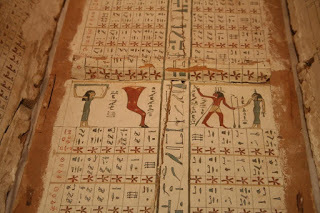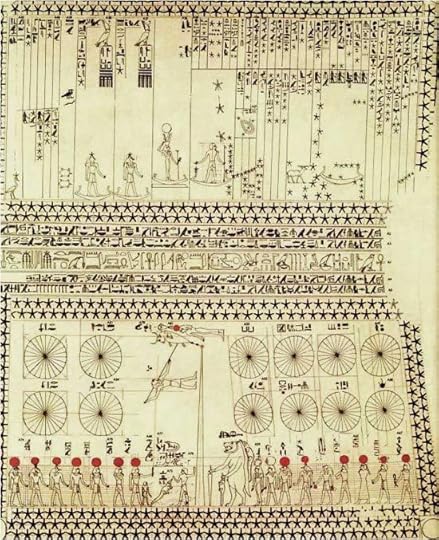Star charts reveal how ancient Egyptians planned to navigate the sky after death
Ancient Origins
 Star charts reveal how ancient Egyptians planned to navigate the sky after death Like others in the ancient world in the Americas, Asia, Europe and around the Mediterranean, Egyptian pharaohs and nobles associated stars with their gods or thought they could be deified by becoming immortal stars in the night sky. They tried to ensure their ascension and navigation of the night skies by having elaborate star charts and calendars painted in their tombs. They also had eyes painted on their coffins so they could see what was going on in the world.
Star charts reveal how ancient Egyptians planned to navigate the sky after death Like others in the ancient world in the Americas, Asia, Europe and around the Mediterranean, Egyptian pharaohs and nobles associated stars with their gods or thought they could be deified by becoming immortal stars in the night sky. They tried to ensure their ascension and navigation of the night skies by having elaborate star charts and calendars painted in their tombs. They also had eyes painted on their coffins so they could see what was going on in the world.Sarah Symons, a researcher from McMaster University in Ontario, Canada, says she believes the stars painted on the outsides of coffins were like a map for the dead to navigate the night skies. Scholars previously thought they were like clocks for keeping time, which would have been important for certain rituals, says Scientific American in an article about Symons’ research.
The article states:
“Her conclusions are based on years of research into ancient Egyptian beliefs, extensive surveys of the 27 known star tables or fragments of tables in the world and, using planetarium software, the ability to easily recreate the nighttime sky as it appeared more than 4000-odd years ago along the Nile. Symons and co-author Elizabeth Tasker of Hokkaido University in Japan describe the work in the October issue of Scientific American.”The star charts’ layout has been understood for decades, Symons and Tasker write. The ancient astronomers’ paintings on some of the tombs divided a table into quarters with a vertical and a horizontal stripe. Along the horizontal stripe is a line invoking a number of Egyptian gods with an offering. Along the vertical stripe they painted images of four of the gods.
The Scientific American article examines the star table of Idy of Asyut, which has one of the best-preserved star tables. It is housed at the University of Tübingen Museum in Germany.
 The sky goddess Nut in an ancient Egyptian star chart that differs from the one studied by Sarah Symons and Elizabeth Tasker. (Photo by GoldenMeadows /
Wikimedia Commons
)Across the top of the table is printed the civil Egyptian calendar of 10-day weeks and 12 months of 30 days, for a total of 360 days. They painted on the “half week” of five odd days at the year’s end in a column at the table’s end.
The sky goddess Nut in an ancient Egyptian star chart that differs from the one studied by Sarah Symons and Elizabeth Tasker. (Photo by GoldenMeadows /
Wikimedia Commons
)Across the top of the table is printed the civil Egyptian calendar of 10-day weeks and 12 months of 30 days, for a total of 360 days. They painted on the “half week” of five odd days at the year’s end in a column at the table’s end.They printed the star names in hieroglyphics in columns with 12 rows. Every cell depicts the rising or setting of a certain star over the horizon, Scientific American says.
 The star chart of Senemut, which differs from the one detailed in the Scientific American article. (Photo by SenemmTSR/
Wikimedia Commons
)Idy’s star chart depicts the goddesses Nut, the god Sahu and the leg of an ox, among other deities. Nut was the goddess of the sky, and she is seen holding up the heavens on the star chart. Meskhetiu, or the ox leg, shows seven stars, which scholars think represent the constellation of the Big Dipper.
The star chart of Senemut, which differs from the one detailed in the Scientific American article. (Photo by SenemmTSR/
Wikimedia Commons
)Idy’s star chart depicts the goddesses Nut, the god Sahu and the leg of an ox, among other deities. Nut was the goddess of the sky, and she is seen holding up the heavens on the star chart. Meskhetiu, or the ox leg, shows seven stars, which scholars think represent the constellation of the Big Dipper.Idy’s star chart also shows Sopdet or Sirius rising above the horizon. Sirius was absent for the sky for about 70 days in ancient Egypt. Its rise after the absence every year signaled the vitally important Nile flood.
The star table of Idy does not show all of the columns of the ideal star table. “Even partial representations were apparently powerful enough to allow the dead to access the complete chart in the afterlife,” Scientific American says.
Featured image: A detail of the star chart of Idy of Asyut showing the sky goddess Nut holding up the heavens at the top. (Photo by Einsamer Schütz / Wikimedia Commons )
By Mark Miller
Published on September 18, 2015 06:21
No comments have been added yet.



